After the election: What different scenarios mean for Alberta
This is Alberta. Anything can happen.

As we enter the final week of Alberta’s election campaign, the two main party leaders are criss-crossing the province to rally their supporters.
United Conservative Party leader Danielle Smith made several campaign stops in and around Edmonton during the first two days of the May long-weekend, including in the Edmonton-Decore, Drayton Valley-Devon, Fort Saskatchewan-Vegreville and St. Albert ridings. The NDP are expected to sweep the capital city but the suburban ridings surrounding the city currently held by the UCP are hotly contested by the two parties.
Alberta NDP leader Rachel Notley was in the same neck of the woods, attending events in south east Edmonton, Leduc-Beaumont and Sherwood Park before heading down the QEII for a rally in Red Deer and then on to Calgary. Notley is expected to spend most of the next week in battleground Calgary, where the NDP has set up its campaign HQ and has hopes of making major gains.
What happens in the next 7 days could determine the outcome of this closely fought election campaign. But what will happen on May 29?
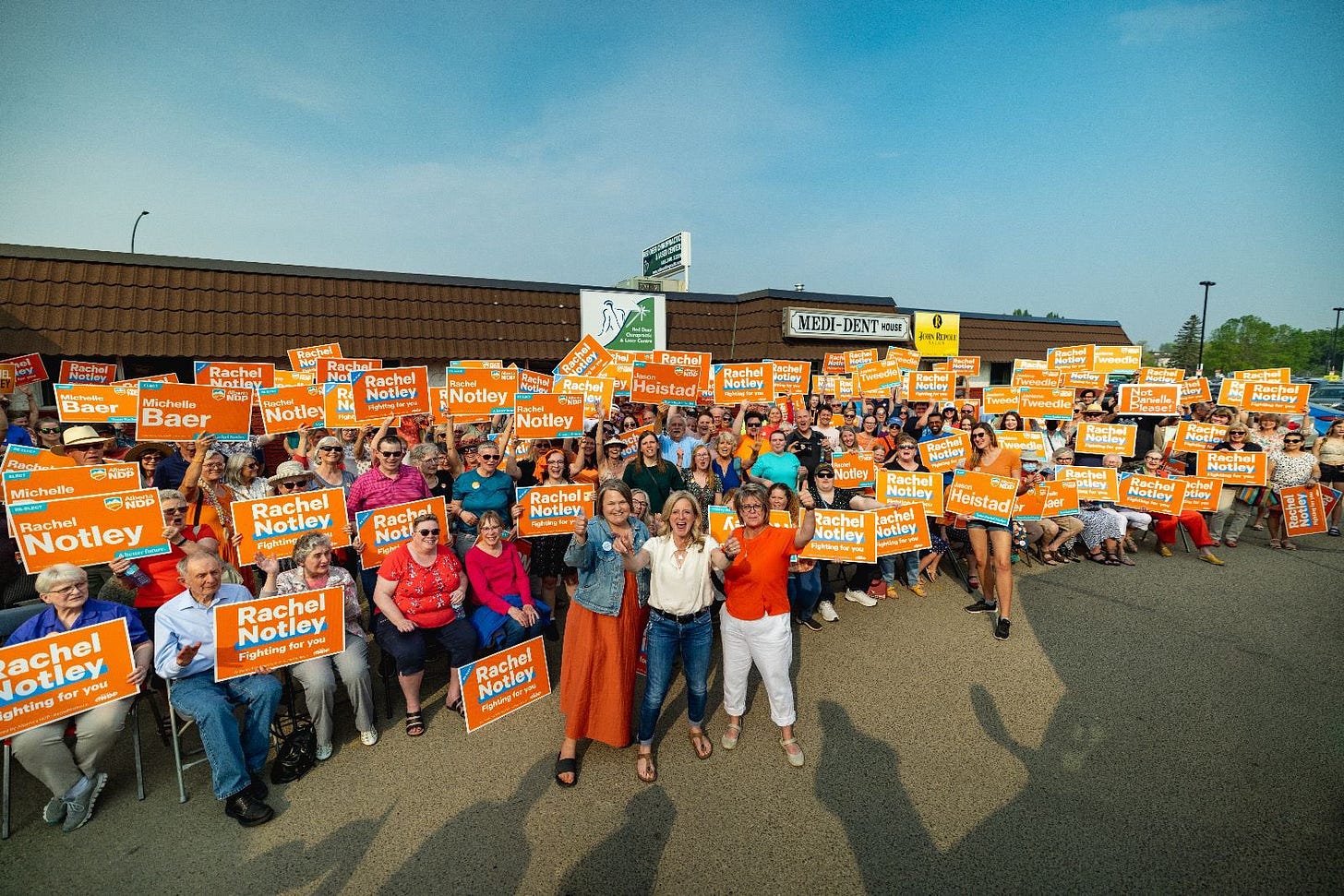
In today’s guest commentary, Chris Henderson of Y Station Communications & Research takes a look at what might be in store for Alberta’s political parties and dynamic after the election through four scenarios. Chris’ analysis is spicy and I think many of you will enjoy it.
Thank you to everyone who has read, shared, subscribed to the Daveberta Substack. If you enjoy what you read here today, share it with a friend or coworker or share it on social media. If you have any feedback, please feel free to leave a comment below or send me a message.
Dave
PS. Advance voting is open from May 23 to 27. Vote early and vote once.
After the election: What different scenarios mean for Alberta
By Chris Henderson
Before the collapse of the Progressive Conservative Party in 2015, being a PC Party member – or at least participating in PC Party events – was extremely normal. Normal to the point that it was barely political.
If you were a business or a non-profit that depended on government policy, you were a participator to some extent – you kind of had to be. As a decades-old political dynasty, it was the only game in town, and the political dynamic in Alberta showed it.
Even with the slow upstart rise of the Wildrose Party creeping up from behind, the three races for leader of the PC Party after Ralph Klein were seen as, in no uncertain terms, the real election in Alberta.
The PC Party had so much gravity after being in office for so long, and the party’s tent was so artificially big, that it stunted the growth of other political parties in the centre of the spectrum.
Then, after 44-years of dynasty-building, it all went kablooey.
On May 5th, 2015, the Alberta NDP increased their seat count by 50 seats and won an outright majority in the Alberta legislature. Through a combination of vote splitting on the right, the public getting visibly fed up with the most recent five years (at least) of shenanigans within the PC Party, and a great performance by the Alberta NDP that positioned them as a credible place to park your vote, there was a seismic shift in Alberta politics that seemed unlikely even a few months earlier.
The PC Party, no longer with any meaningful lever of influence, completely shattered. Many breathed a sigh of relief because they didn’t have to pretend anymore, some panicked because of a loss of access or status, and some found new political teams.
Just over two years later in July 2017, the PC Party of Alberta, an institution that many took for granted as indestructible, was gone, only to be remembered in look-back posts on the Daveberta Blog. Wacky stuff.
On May 29th, 2023, we may see another major shift in the landscape. Let’s take a look at what might be in store for Alberta’s political parties and dynamic after the election through four scenarios, in ascending order of their spiciness:
Scenario One: Big win for the UCP
Potential Seat Count: 67-20 (UCP/NDP)
Spice Level: Plain crackers.
This would confirm what people say every provincial election in Alberta: that this is a conservative province that only votes for conservatives, almost as a reflex, and it’s impossible for a centre or centre left party to win here consistently.
If the United Conservative Party holds the fort in Calgary and pick up some seats in Edmonton, they may post a big, big win. In that case, everything on the Good Ship UCP is just fine. Rumours of Danielle Smith’s ouster being floated on the doors by UCP candidates? Liberal media nonsense. A major divide between more centrist conservatives and the convoy-born Take Back Alberta organizers? How dare you? – we’re a big happy family. Buy a UCP membership or else.
A UCP that can find motivation to keep itself united after a big win would initiate a self-perpetuating political dynasty that could last decades, with Danielle Smith as the defining force in Alberta politics. A lot of people would start practicing how to kiss the ring again.
This result would mean a reckoning for the NDP, though. While still holding an appreciable number of seats, a loss of this magnitude in an election like this would probably trigger a drain of staff, candidates, and donors.
The leadership of Rachel Notley would also be examined closely – that’s what happens when your party drops seats in an election you were poised to make gains in.
The NDP would need to ask itself what direction it needed to head in to be competitive and who would be captain of that ship. This is not the 2004 Alberta NDP – this soul-searching would be a sophisticated and complex conversation – perhaps one that may consider a broader rebrand.
Scenario Two: A convincing NDP win
Potential Seat Count: 48-39 (NDP/UCP)
Spice Level: Not mild, not medium, but hot grocery store salsa.
This would produce relative stability at the legislature, and perhaps produce a true centrist government.
A victorious NDP, campaigning on being a solid, stable choice that you can trust, will likely want to govern from a position closer to the pragmatic centre, keeping as many people happy as possible, even moreso than last time it was in government. Avoiding a loss like in 2019 will be at the forefront of their minds, and they will act accordingly.
Rachel Notley, who has exercised significant control over her party as leader, would continue that approach to contain MLA-level scandals and would likely bring in some top talent from outside of Alberta to help keep things running smooth. This would be Rachel’s party and she will be looking to shed the “accidental government” label that haunted them after the 2015 election. Smart moves in office, continued distance from their federal counterpart and a few calculated jabs in Ottawa’s direction could position them to grow.
For the UCP in this scenario, they will be preoccupied with two things: attacking the NDP, and attacking each other. Danielle Smith would only be leader of the party for as long as it took for her caucus find a pen she could sign her resignation with.
The infighting after that will be epic (think Succession, but everything is beige). This is the setting that may cause the UCP to smash their fragile alliance into pieces and give Albertans a series of competing conservative options, taking us right back to 2015.
If the UCP does tear itself apart, there is a real chance that the NDP set themselves as the new political dynasty in Alberta. If the UCP manage to hold it together, politics in Alberta will remain relatively competitive.
Scenario Three: A minority government
Seat Count: 43-1-43
Spice Level: A Guatemalan Insanity Pepper, eaten whole.
The only true minority possibility on the horizon is if Alberta Party Leader Barry Morishita wins his seat. It’s a remarkably remote possibility. Any other potentially viable independent will vote in lockstep with the UCP (Jennifer Johnson or Tim Hoven, for instance), even if they remain an independent.
This scenario is very similar to the one where the NDP win. If Morishita wins, he would hold the balance of power and can go wherever he wants, but will likely not want to indulge the more extreme elements of either party. This is his chance to break the Alberta Party out of year 12 of its impending breakthrough. He will want to build party profile and put an Alberta Party stamp on the province. He will need to be strategic and clear about his choices.
Don’t envy the person in this position. They would be integral to selecting the Premier, likely through a confidence and supply agreement and would be constantly testing the political wind to make sure things don’t fall apart and that they can maintain influence for the future prospects of the Alberta Party. That’s going to result in some very bizarre political calculations.
Because Morishita is running against Danielle Smith in Brooks-Medicine Hat, his winning means Smith would not have a seat and her party will likely take that opportunity to cut her loose. Notley will likely remain NDP leader, even if she doesn’t become Premier in this arrangement, and continue to maintain tight control on the party for the next few years. If she can’t get bills through, however, she’ll get dusted.
For Albertans, this means a government that would be watched intensely across the country. But this would be a drastically new arrangement for governing Alberta – who knows how well it will work in practice. Chances are, Albertans would be back at the polls in short order.
Scenario Four: UCP majority, but just barely
Potential Seat Count: 46-41 (UCP/NDP)
Spice Level: A pepper so hot, you melt like you’re staring into the Ark of the Covenant.
Alberta politics would devolve into an absolute clown tornado. Alberta would be as divided as it could be, shifting even closer to what we see in US politics, which is… not desirable.
With a poor poll performance, and with the UCP caucus split internally like it is, there will be demands by factions within the party to move their pet agendas forward, with the constant threat of majority instability if they don’t get their way. We saw shades of this under Kenney. But now imagine if a small group of MLAs could do more than just embarrass the party in public. Imagine they have actual power.
In this scenario, Alberta will pass Florida-style legislation about utter nonsense and we would be subject to the worst political instincts of a party constantly trying to patch over raging infighting.
Danielle Smith may not survive a result like this, but in the confusion of everyone in the UCP pointing their finger with one hand and covering their ass with the other, she might find a way to survive. If not, she will not be replaced with a more moderate, sensible choice looking to find a way for everyone to get along.
Even a good, but not good enough, performance from the NDP will seed hope that demographics and attitudes are shifting and Alberta is heading away from a default conservative position. The NDP will have a lot of supporters with a reason to believe that continuing the fight is worth it. This NDP would be very aggressive as an opposition party, raging at the chaos and more controversial legislation the UCP would bring forward. And they will enjoy a very large voter audience to speak to.
Under this scenario, the NDP may receive a majority of total votes, a fact that would underline every talking point they make during the next term. Notley may survive this outcome, but succession planning will be a constant topic as the party starts planning for the 2027 election.
What does this mean for everyone else? Near constant drama in every office at the legislature, with politics, rather than governing (which, remember, is what we elect these members to do), as the primary preoccupation. An entire elected field thinking much more about what’s happening at the legislature and not nearly as much about your kitchen table. This is probably not the government you want in place when we are hit with the next pandemic.
I know these are a bit fanciful. But then again, this is Alberta. Anything can happen. Just ask the Alberta Liberal Party in 2008; the Wildrose Party in 2012; and the PC Party in 2015.
Chris Henderson is Chief Strategist & Partner at Y Station Communications & Research, a company that applies data and insights to work with clients to navigate critical decision making. He used to work on campaigns, but is long retired from that kind of action because he doesn’t need that kind of stress at his age.
Daveberta election lawn signs
I shipped out and delivered another batch of limited-edition Daveberta Election lawn signs this weekend to subscribers and supporters across Alberta. It’s been a lot of fun to connect with and chat with many of you about the election over the past few weeks. If you see a Daveberta lawn sign in the wild, snap a photo and tag me on social media.


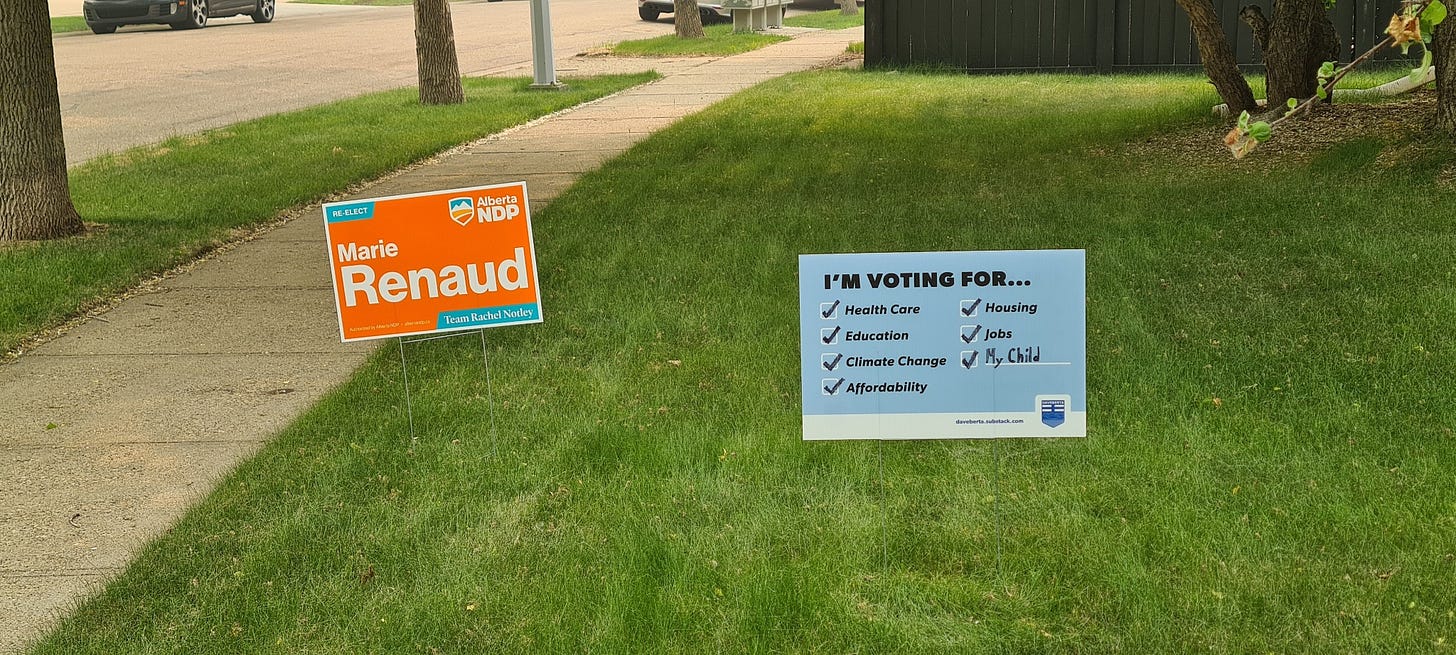
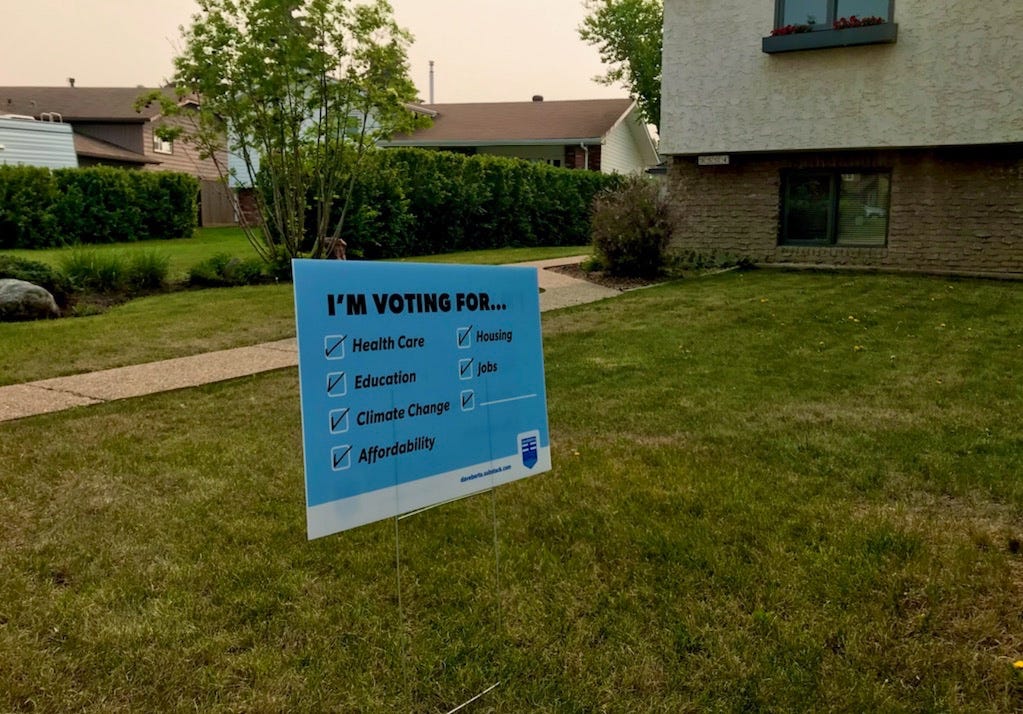
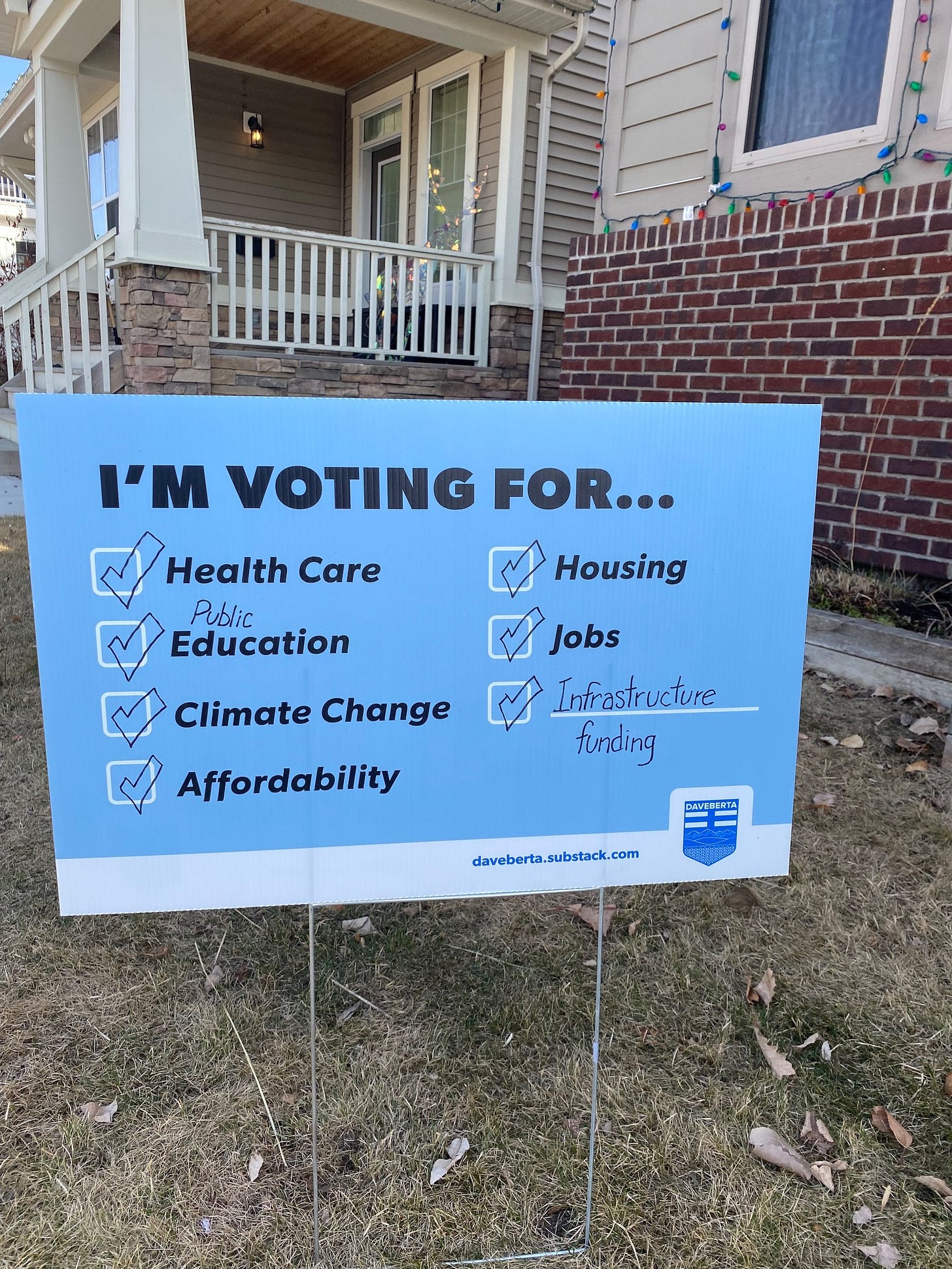
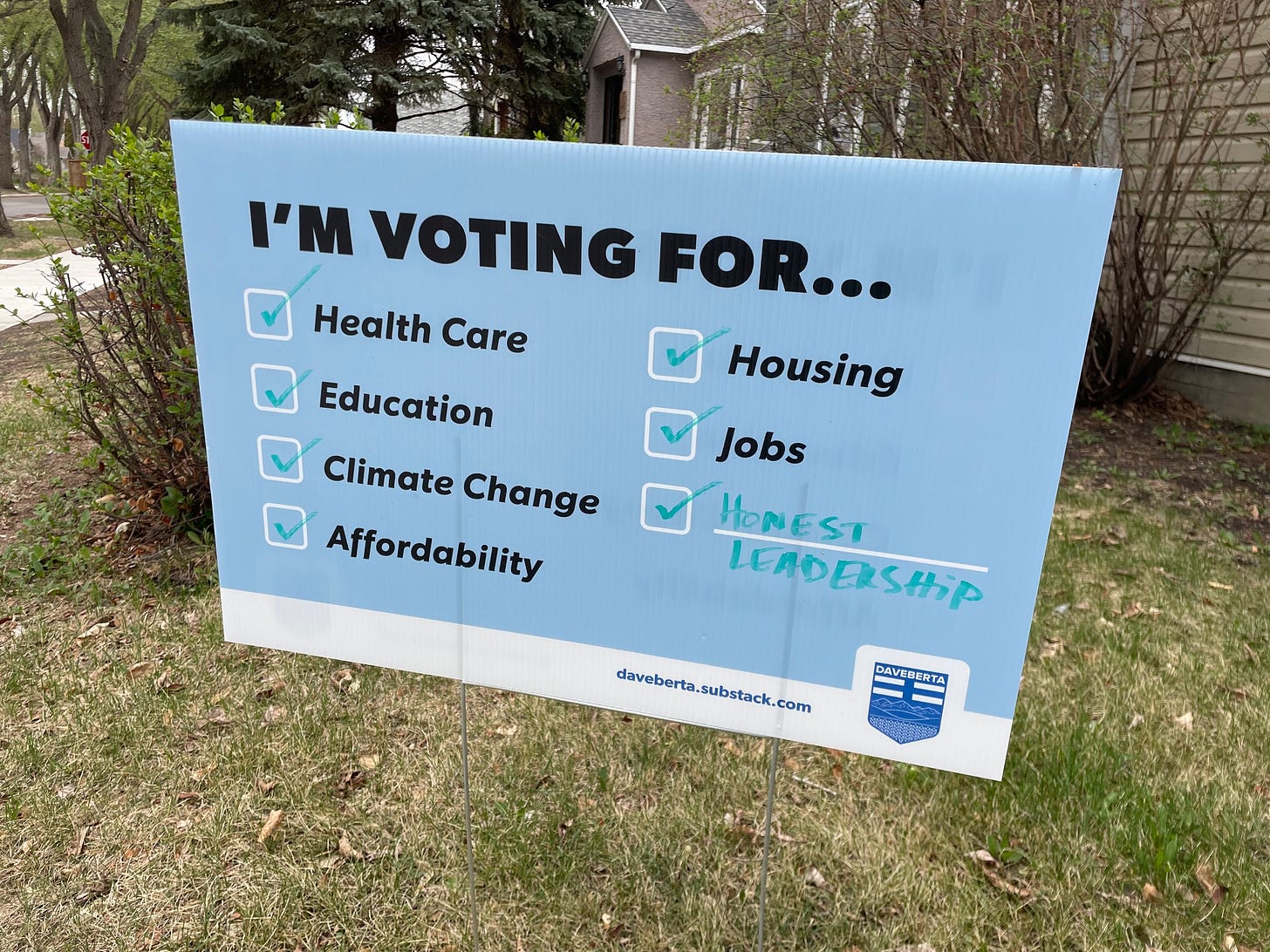
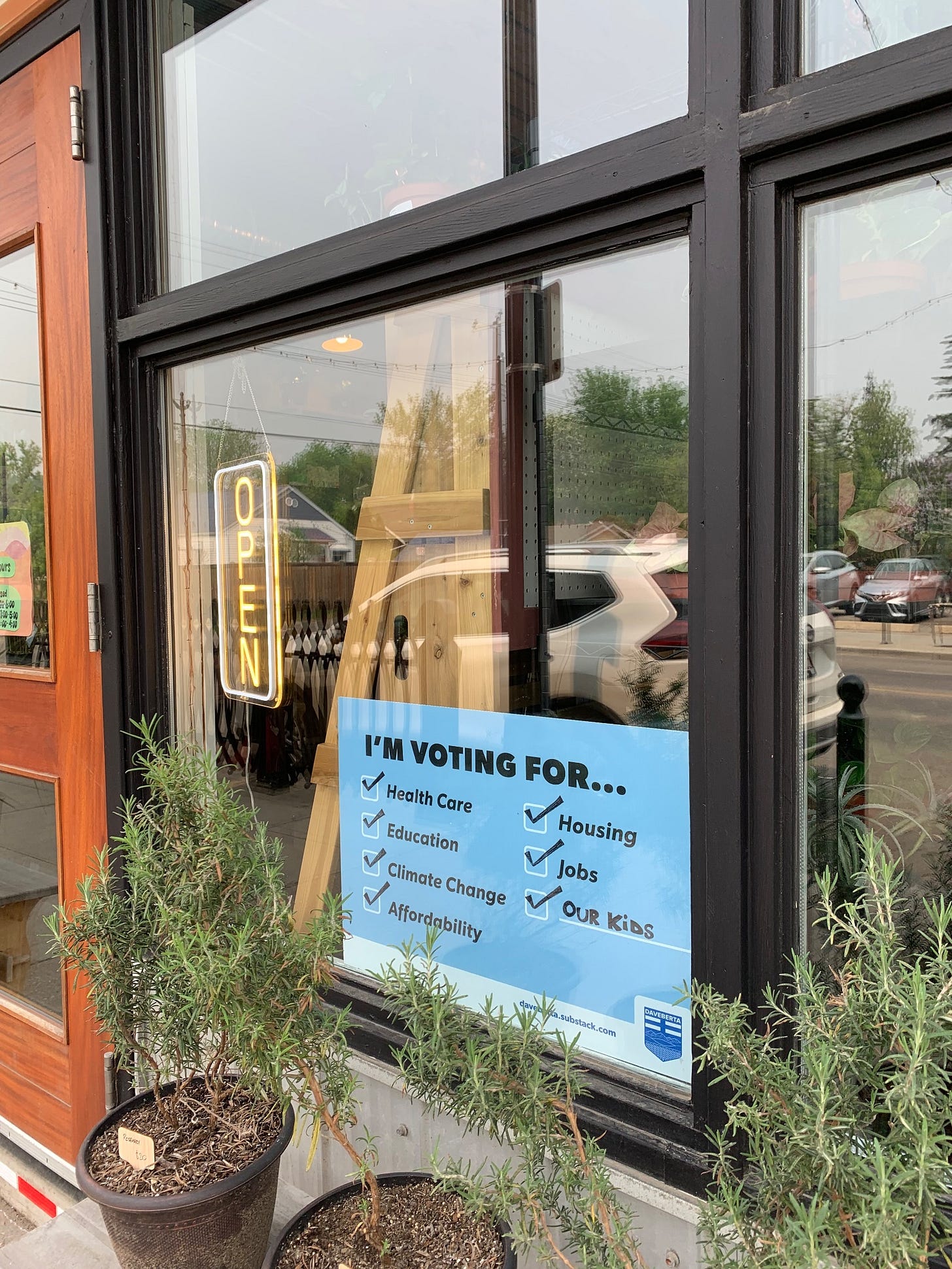
🎙️ Chris joined us on the Daveberta Podcast to do a deep dive into these scenarios: https://daveberta.substack.com/p/daveberta-podcast-an-election-so#details